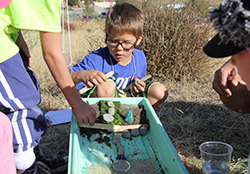 Second graders took on the role of scientist and engineer to figure out how to stop soil erosion at the Landforms Science Field Experience held at the base of Saddlerock. Jill Fineis, Science Field Experience Coordinator, and the Elementary STEM (Science, Technology, Engineering, Math) team, created the event, which includes an engineering design challenge. See facebook photo album.
Second graders took on the role of scientist and engineer to figure out how to stop soil erosion at the Landforms Science Field Experience held at the base of Saddlerock. Jill Fineis, Science Field Experience Coordinator, and the Elementary STEM (Science, Technology, Engineering, Math) team, created the event, which includes an engineering design challenge. See facebook photo album.
The STEM field experience extends classroom science to the outdoors, and aligns to the new Next Generation Science Standards. Washington Elementary teacher Lynda Huson said of the experience, “It’s real. They get to look at a real problem and fix it using real materials in a real setting. You can’t always do that in a classroom.”
Working in groups, second graders first identified landforms they could see, like Saddlerock, Rooster Comb, the Wenatchee Dome, and the Columbia River.
Volunteer Instructor Rosa Eilert talked with the children about water flow and erosion. “Today you’re geologists studying hydrology,” Mrs. ‘E’ told the students. They also learned the engineering process of identifying problems, brainstorming solutions, designing, building, testing, and redesigning.
They learned new science vocabulary, including turbid, sediment and erosion. Students worked in groups, and they used stream table to experiment with erosion control. Groups had to brainstorm a way to hold the soil in place when it rained. They were given materials, including rocks, jute fabric, and grass, to create a design to keep soil from eroding when it rained (water sprinkled from a cup).
Some groups had great success, holding most of the soil in place with very little turbidity in the runoff water, which was collected in a cup at the end of the stream tables. Other groups had flooding, losing little houses and trees that they had placed in the table. Everyone had a chance to brainstorm, go back, redesign, and test again.
Mrs. E explained what she hoped the kids took away from the day. “If you have a problem, if you plan, you can fix that problem using the scientific engineering process.”
Jill Fineis says she is very pleased with this new model for a science field experience because the students are learning STEM principles and teamwork. “Working as a team,” Fineis says, “is just as important of a skill as learning how to engineer.”
All grade K-5 students participate in STEM Field Experiences, including a Kindergarten Habitat Walk, 1st Grade Hill Hike up Jacobson Preserve and 5th Grade Shrub Steppe'n up Saddle Rock.
/washingtonlogo.png)